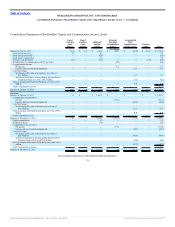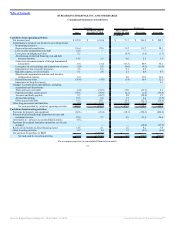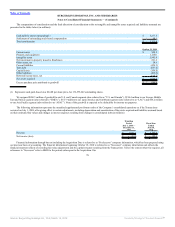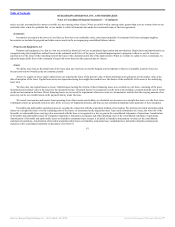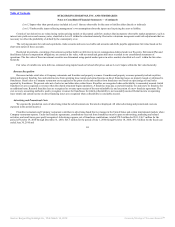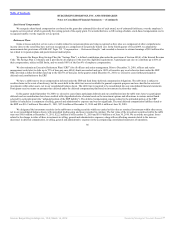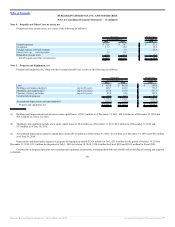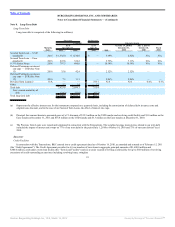Burger King 2011 Annual Report Download - page 82
Download and view the complete annual report
Please find page 82 of the 2011 Burger King annual report below. You can navigate through the pages in the report by either clicking on the pages listed below, or by using the keyword search tool below to find specific information within the annual report.
Table of Contents
BURGER KING HOLDINGS, INC. AND SUBSIDIARIES
Notes to Consolidated Financial Statements — (Continued)
and as a result, are transferred to notes receivable at a net carrying value of zero. Notes receivable with a carrying value greater than zero are written down to net
realizable value when it is probable that we are unable to collect all amounts due under the contractual terms of the loan agreement.
Inventories
Inventories are stated at the lower of cost (first-in, first-out) or net realizable value, and consist primarily of restaurant food items and paper supplies.
Inventories are included in prepaids and other current assets in the accompanying consolidated balance sheets.
Property and Equipment, net
Property and equipment, net, that we own are recorded at historical cost less accumulated depreciation and amortization. Depreciation and amortization are
computed using the straight-line method based on the estimated useful lives of the assets. Leasehold improvements to properties where we are the lessee are
amortized over the lesser of the remaining term of the lease or the estimated useful life of the improvement. When we commit to a plan to close a restaurant, we
adjust the depreciable lives of the restaurant’s long-lived assets based on the expected date of closure.
Leases
We define lease term as the initial term of the lease, plus any renewals covered by bargain renewal options or that are reasonably assured of exercise
because non-renewal would create an economic penalty.
Assets we acquire as lessee under capital leases are stated at the lower of the present value of future minimum lease payments or fair market value at the
date of inception of the lease. Capital lease assets are depreciated using the straight-line method over the shorter of the useful life of the asset or the underlying
lease term.
We also enter into capital leases as lessor. Capital leases meeting the criteria of direct financing leases are recorded on a net basis, consisting of the gross
investment and residual value in the lease less the unearned income. Unearned income is recognized over the lease term yielding a constant periodic rate of return
on the net investment in the lease. Direct financing leases are reviewed for impairment whenever events or circumstances indicate that the carrying amount of an
asset may not be recoverable based on the payment history under the lease.
We record rent expense and income from operating leases that contain rent holidays or scheduled rent increases on a straight-line basis over the lease term.
Contingent rentals are generally based on sales levels in excess of stipulated amounts, and thus are not considered minimum lease payments at lease inception.
Favorable and unfavorable operating leases are recorded in connection with the acquisition method of accounting. We amortize favorable and unfavorable
leases on a straight-line basis over the remaining term of the leases, as determined at the acquisition date. Upon early termination of a lease, the write-off of the
favorable or unfavorable lease carrying value associated with the lease is recognized as a loss or gain in the consolidated statements of operations. Amortization
of favorable and unfavorable leases on Company restaurants is included in occupancy and other operating costs in the consolidated statement of operations.
Amortization of favorable and unfavorable leases on franchise restaurants lease receipts is included in franchise and property revenues in the consolidated
statement of operations. Amortization of favorable and unfavorable leases on franchise restaurants lease commitments is included in franchise and property
expenses in the consolidated statement of operations. (See Note 9.)
81
Source: Burger King Holdings Inc, 10-K, March 14, 2012 Powered by Morningstar® Document Research℠





